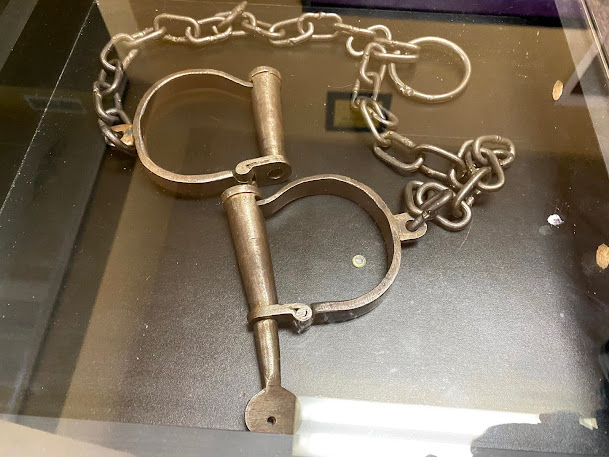Harriet Tubman And The Underground Railroad
On October 30, we moved our boat to Cambridge, Maryland, so we could visit the Harriet Tubman Museum.
I watched a documentary on the trip over so I would know something about her before.
Here’s what I learned about this amazing person from the video, my own research, and our visit to the museum.
________
Harriet Tubman was born into slavery in Dorchester County, Maryland around 1820. Her birth name was Araminta Ross. She was nicknamed “Minty.”
Her parents had been sold to different plantations hundreds of miles apart. It was sad to learn most slave families were broken apart like this.
At the age of six, she was loaned out by her owner to another plantation for the amount of $60 per year. Her job was to watch over a young infant. If and when the infant would cry, Harriet was whipped. In fact, she was cruelly abused, mentally and physically, throughout all her years as a slave, enduring things like collecting muskrats from traps while constantly wet, working through measles sickness, and even hiding for days in a pigpen to avoid punishment.
When she was an adolescent, she suffered an injury that changed her life. While in a store, she was hit by a 2 pound iron weight the shop owner had thrown at another slave. Though this nearly killed Harriet, she survived. However, she suffered permanent brain damage that left her with severe headaches, buzzing sounds, and seizures. She also began having visions so powerful, she though they were messages from God. Her deep spirituality stayed with her her entire life.
In 1849, at the age of 29, she learned she was going to be sold to a southern plantation. Instead, she made the decision to run away.
She ran a distance of 100 miles — all at night — navigating only by the north star. She was assisted at times by the Underground Railroad (It is not an actual a real underground railroad, but a network of routes and safe houses that enabled tens of thousands of slaves to find their freedom).
She arrived in Pennsylvania, a state that did not allow slavery. At last she was free, though not legally. She had to be careful not to be caught and returned to her owners by bounty hunters.
She described that moment she when she crossed the Pennsylvania boarder:
“I looked at my hands to see if I was the same person now I was free. There was such glory over everything. The sun came up like gold through the trees and I felt like I was in heaven.”
Years later she described slavery as she saw it:
“Slavery is the next thing to hell.”
__________
Most people who had suffered what Harriet Tubman suffered, would begin a new life and NEVER return to the past. However, Harriet Tubman was an exceptional woman. She became a “conductor” of the same Underground Railroad that had helped her. She returned 13 times (!) to the plantations of her youth over the course of 10 years, bringing back 70 slaves to their freedom.
“I was the conductor of the Underground Railroad for eight years, and I can say what most conductors can’t say — I never ran my train off the track and I never lost a passenger.”
- Harriet Tubman, at a suffrage convention, NY, 1896.
______
Her drive to end slavery didn’t stop when the Civil War began.
She volunteered to become a scout of enemy positions as well as a mapmaker of unfamiliar territory to assist Union forces.
But she had a far greater role in the Civil War than that. She became the first American woman to lead an armed assault. She guided three steamboats on the Combahee River, around confederate mines, to attack local plantations. Her troops burned the plantations, crippled the infrastructure, and captured valuable supplies. The slaves of those plantations — men, women, and children — rushed onboard her ships, despite efforts of the slave owners to stop them. When the battle was over, Harriet Tubman had freed another 750 slaves.
Despite her efforts to support the Union, Harriet Tubman was denied any salary or compensation. As a result, after the war, she was very poor. Friends and admirers did what they could to help support her.
As she grew older, she took up a new cause: women’s suffragist rights. This earned her the respect and friendship of the famous suffragist Susan B. Anthony and even higher admiration by great abolitionist and writer, Frederick Douglass.
Here is what Douglas wrote to her in 1869.
“The difference between us is very marked. Most that I have done and suffered in the service of our cause has been in public, and I have received much encouragement at every step of the way. You, on the other hand, have labored in a private way. I have wrought in the day – you in the night. I have had the applause of the crowd and the satisfaction that comes of being approved by the multitude, while the most that you have done has been witnessed by a few trembling, scarred, and foot-sore bondmen and women, whom you have led out of the house of bondage, and whose heartfelt, “God bless you,” has been your only reward.
The midnight sky and the silent stars have been the witnesses of your devotion to freedom and of your heroism. Excepting John Brown – of sacred memory – I know of no one who has willingly encountered more perils and hardships to serve our enslaved people than you have. Much that you have done would seem improbable to those who do not know you as I know you. It is to me a great pleasure and a great privilege to bear testimony for your character and your works, and to say to those to whom you may come, that I regard you in every way truthful and trustworthy.”
Your friend,
Frederick Douglass
Later in life she gave a small piece of property to have a home built for elderly, former slaves, the first such home.
Harriet Tubman, who suffered unspeakable hardships, lived 91 years! It’s remarkable to think that all this was accomplished by a former, abused slave, who lived with a painful, permanent brain injury, by a woman during a time when rights were restricted, and by someone who was only 5 feet tall.
Her headstone reads:
“Servant of God, well done.”
“If I could have convinced more slaves that they were slaves, I could have freed thousands more.”
- Harriet Tubman
__________
Here are some images from the museum.
The boarder between the northern states and the southern states
The front of the Harriet Tubman Museum. The man in the other poster is Frederick Douglass.














You are quite a historian, Salter. I’ve shared your article with your cousins too. Next time you are coming through Cleveland, stop in Hudson, OH. The town has quite a storied history with the Underground Railroad. https://www.hudsonlibrary.org/historical-society/underground-railroad-sites-in-hudson-ohio/
ReplyDeleteThis is a great post, Salty. I never knew some of these facts about Harriet Tubman. President Lincoln was one of our greatest Presidents. I have a book for you to read when you get home. It's a graphic novel all about the Gettysburgh Address, given by Lincoln during the Civil War. You and Dad should stop Hudson, like Aunt Noreen says above, and learn more about the Underground Railroad.
ReplyDeleteGreat post, Salter. When I was your age, we learned about Harriet Tubman and the history of the Underground Railroad and it's connection to SW Michigan. The railroad reached north with slaves passing through Michigan on their way to Canada.
ReplyDeletehttps://www.secondwavemedia.com/southwest-michigan/features/The-Underground-Railroad-Tour-Social-justice-in-a-space-and-place-0518.aspx